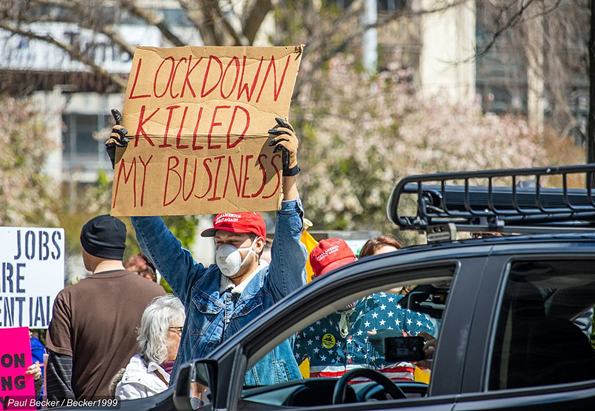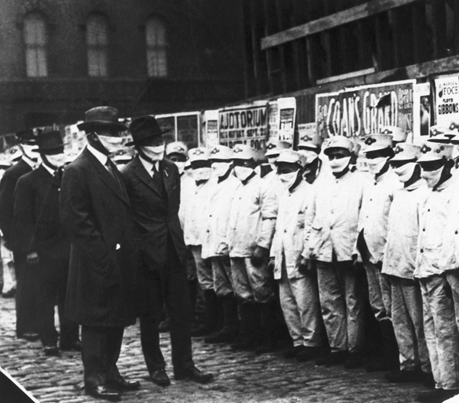Are you going to pay my rent!?
If you’re not going to pay my rent, I’m not closing!
You guys still time after time are giving me citations, telling me I have to close my business – what about my employees?
Business Owner Anton Van Happen, December 2020
Such were the cries of Anton Van Happen, a restaurant owner in Ventura, California who, in December 2020, faced citations from the city’s health department for “keeping his business open in violation of a state coronavirus lockdown” (Nelson). Despite following California’s regulations regarding social distancing and mask-wearing, local officials cracked down on Van Happen and forced his restaurant to close. In the wake of this closure, he was left to find a way to continue providing for not just his family, but the employees who no longer had work.
When it comes to how we visualize and understand the COVID-19 pandemic, it is the loss of life, the dreadful illness and its spread that encapsulates the public consciousness. However, there is a dark side to that coin that seldom gets the light of day; the human cost that does not involve a loss of life, but a loss of livelihood. As we continue to navigate the coronavirus pandemic, the economic cost of prolonged lockdowns and health measures is profound. As per a Pew Research study from September, just six months into the pandemic “one-in-four adults have had trouble paying their bills” and “25% of U.S. adults say they or someone in their household was laid off or lost their job” due to the pandemic (Parker et.al, 2020). Going beyond the economic hard-times of the common American, in Connecticut alone, an Opportunity Insights report illustrated that “37% of Connecticut small businesses this year closed because of COVID-19 disruptions and restrictions” (CBIA). In a country in which many already struggled to obtain a comfortable daily living, the pandemic certainly did not do them any favors, especially when their sources of employment dropped like flies.

Despite the fact that, in the scope of human history major government interventions into business during pandemics is a relatively new venture, the lockdowns and business closures that took place during the COVID-19 pandemic are rooted in historical precedence. In terms of economic interventions, there appears to be no better a pandemic to relate to than the 1918 Spanish Influenza pandemic. In the second wave of the pandemic, which took place during the last quarter of 1918, the ferocity of influenza instigated reactions across the nation. However, unlike the widespread and almost uniformly strict measures taken at the state and municipal levels, during Spanish Influenza the response was largely decentralized and unique across a wide variety of municipal jurisdictions. Some cities like Portland took rather tepid measures aimed at reducing gatherings, in which enforced closing hours were established for “wholesale and retail stores” that were set to “close at 3:30 PM” (Oregon Daily Journal, 1918). Portland’s decision to enforce tighter business hours and close places of gathering like schools and churches was echoed within other cities across the United States, with some greater degrees of severity.
When Spokane’s city government levied restrictions on gatherings and business hours, the so-called business ban was extended to enforce closures upon stores and business that did not follow health regulations. The Spokane health officer had led this effort under the pretense that “unless business houses of Spokane meet the requirements” established by the city’s health officials for quarantine, “they will be closed tight” (Spokane Daily Chronicle, 1918). Just as in the case of cities like Ventura, Spokane during Spanish flu actually enforced its mandates and wielded the power of the health office to enforce business closures upon businesses that did not comply with Spokane’s public health measures.
Interestingly enough, there were several cities that established hard-coded “Anti-Influenza Ordinances” that, above all, criminalized and made punishable certain actions people would take to conduct business during the pandemic. Los Angeles did just that, in which, as per the Los Angeles Evening Herald, the city’s council had it codified and punishable for those who tried to “keep open” their businesses, “or to cause or permit them to be open” (Los Angeles Evening Herald). This strict measure was deployed not just to retail and other businesses with a wide variety of costs and employees, but also to churches, schools, and theater, among other modes of gathering. If this sounds familiar, that is because it likely echoes the harsh measures implemented at the start of the COVID-19 pandemic, in which dozens of cities implemented strict lockdowns, business closures and travel restrictions. Even the restrictions from Los Angeles during Spanish Flu were quite steep for the time, as violators of the city’s Anti-Influenza Ordinance were subject to either a $500 fine, six months imprisonment, or a combination of the two (Los Angeles Evening Herald).

Much unlike the lockdowns which took place during the COVID-19 pandemic, the municipal interventions did not last a significant period of time. Most can likely recall significant government measures, such as business restrictions, taking place from the beginning of the outbreak in the US in March of 2020 up until the late summer of that year, in which they were re-instated in the late Fall and early Winter to combat the holiday wave of COVID. However, in the midst of a very disjointed and uncoordinated response to Spanish Flu, “many cities passed sweeping public-gathering bans for a short period during the 1918-1919 pandemic” (Tomes). Even in cities like San Francisco where the pandemic was multi-faceted and reoccurring, intervention measures took place over just several weeks at a time. It is reasonable to figure that whatever economic cost was suffered during these measures would stand to echo those incurred from the months-long quarantine and lockdown periods during COVID.
Even though lockdown measures were rare at the time, public health interventions into the economy on part of municipal governments during the Spanish flu clearly harken to, and form the backdrop of, a lot of the measures that we’ve seen and experienced today. The impact of these measures, in aggregate, also fits a similar bill to that of measures during COVID-19. As historian and economist Howard Bodenhorn notes in his working paper Business in a Time of Spanish Influenza, the wide variety of measures taken to combat Spanish flu saw strong consequences for American businesses and workers. Across the board, public measures resulted in a “toll on local businesses of all kinds”, in which “retail sales fell…worker absenteeism increased, and manufacturing productivity declined” (Bodenhorn, 2). Given shorter hours, several business closures and the pressure during the time of Spanish flu, it makes sense that the economy had suffered so. Even on a macroeconomic scale, it is estimated that the sum total of lockdowns resulted in a “6% decline in GDP and 8% decline in consumption” (Bodenhorn, 43). As it appears, be it during Spanish flu or COVID, there exists a tremendous cost to the economy at large, especially for the workers of businesses that had to be closed. This cost appears to have risen out of city governments enforcing closure mandates, limiting times, and deploying other strategies to combat the spread of the pandemic. Finally on the subject, the well-storied history of local governments getting involved in limiting business to combat pandemics like Spanish flu do well to contextualize and provide precedent to some of the measures that we combat or see unfair today.

But what now? Is there a right way to promote and enforce public safety while protecting the property rights and livelihoods of the businesses that otherwise would be pushed aside? Well, given the historical and contemporary evidence, lockdowns and closure measures hold a haunting impact on the economies in which they took place. Should there be another pandemic in the future, it will be critical for government to strike a balance between public safety and personal wellbeing. This is because, as the aggregate of Spanish Flu may show, too little intervention could lead to thousands of deaths. On the other hand, the sheer economic cost that many experience due to having their businesses closed can’t simply be ignored. Retrospectively, a government policy that establishes public measures but remains sensitive to the needs of business owners and their workers would be ideal. Municipal governments may achieve this during the current pandemic, or moving forward, by crafting a policy that mixes social distancing, mask-wearing orders and expanded access to medical resources. Meanwhile, policies such as the COVID stimulus packages, payroll protection programs, and small business grants could aid to mitigate the economic cost while public health measures are in place. Perhaps, on a more skewed level, governments could prioritize keeping businesses open while ensuring that, for those Americans who fall ill during a pandemic, there is greater access to higher quality treatment and medical care.
Whatever the case may be, the economic hard-times being faced right now is in many ways preceded by what occurred during the Spanish flu pandemic. The very business closures and use of government resources to punish businesses may have varied in 1918, but the general idea and methods have long since survived up until today with their usage by many municipalities. Though we have repeated and enhanced many of the measures taken back then, it is important to recognize when these measures may be going too far in causing or exacerbating the economic damage these pandemics have left in their wake. Hopefully, moving forward, compromise policy could be delivered that preserves public safety while also refraining from punishing or hurting existing business.
Works Cited
Bargain Sales Under Flu Ban, Is City Mandate, Michigan Publishing, University Library, University of Michigan, 12 Oct. 1918, hdl.handle.net/2027/spo.0000flu.0011.000.
Bodenhorn, Howard. “Business in a Time of Spanish Influenza.” NBER, 6 July 2020, www.nber.org/papers/w27495.
Nelson, Joshua Q. “California Restaurant Owner Who Yelled at Inspectors Blasts ‘Extremely Unfair’ Coronavirus Restrictions.” Fox News, FOX News Network, 16 Dec. 2020, www.foxnews.com/us/california-restaurant-owner-yells-health-inspectors-coronavirus-viral-video.
New Law To Protect Health Passed, Michigan Publishing, University Library, University of Michigan, 11 Oct. 1918, hdl.handle.net/2027/spo.0930flu.0005.390.
Parker, Kim, et al. “Economic Fallout From COVID-19 Continues To Hit Lower-Income Americans the Hardest.” Pew Research Center’s Social & Demographic Trends Project, Pew Research Center, 30 Oct. 2020, www.pewresearch.org/social-trends/2020/09/24/economic-fallout-from-covid-19-continues-to-hit-lower-income-americans-the-hardest/.
“Report: Over One-Third of State’s Small Businesses Closed in 2020.” CBIA, 4 Feb. 2021, www.cbia.com/news/small-business/ct-loses-one-third-small-businesses/.
Stores Will Close Early This Week, Michigan Publishing, University Library, University of Michigan, 3 Nov. 1918, hdl.handle.net/2027/spo.0010flu.0008.100.
Tomes, Nancy. “‘Destroyer and Teacher’: Managing the Masses during the 1918-1919 Influenza Pandemic.” Public Health Reports (Washington, D.C. : 1974), Association of Schools of Public Health, Apr. 2010, www.ncbi.nlm.nih.gov/pmc/articles/PMC2862334/.

